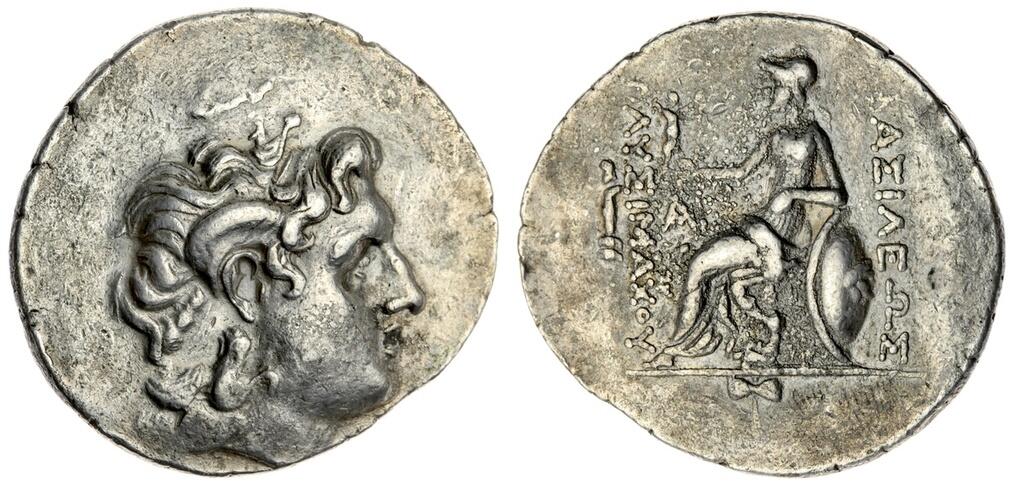Tenedos (types of Lysimachus), silver, tetradrachms (205-160 BCE)
From SILVER
205 BCE - 160 BCE Silver 5,991 kg
Description
| ObverseInscription or printing placed on the obverse.: | Bust of Alexander the Great with Ammon horn right |
| ReverseInscription or printing placed on the reverse.: | ΒΑΣΙΛΕΩΣ ΛΥΣΙΜΑXΟΥ (Greek).Athena enthroned l., her l. arm resting on round shield, holding Nike on outstretched r. hand, Nike crowning the king's name, in inner l. field, monogram A--, Double headed axe in exergue |
Mint and issuing power
| MintIdentifies the place of manufacture or issue of a numismatic object.: | Tenedos | Ancient regionAncient region.: | Troas | Modern countryModern country: Turkey | AuthorityIdentifies the issuing power. The authority can be "pretended" when the name or the portrait of X is on the coin but he/she was not the issuing power. It can also be "uncertain" when there is no mention of X on the coin but he/she was the issuing power according to the historical sources: | Lysimachus (Macedonian officer, diadochus and king, c. 360-281 BC) |
Chronology
| FromIdentifies the initial date in a range assigned in a numismatic context. | 205 BCE | toIdentifies the final date in a range assigned in a numismatic context.. | 160 BCE | PeriodTime period of the numismatic object.: Hellenistic 323-30 BC |
Physical description
| MetalThe physical material (usually metal) from which an object is made.: | Silver |
Median weightMedian of the weights of numismatic objects (in grams). in grams | 16.80 | DenominationTerm indicating the value of a numismatic object. Examples: tetradrachm, chalkous, denarius.: | tetradrachm |
StandardStandard.: | Attic |
Image

S 1556 - Tenedos (types of Lysimachus), silver, tetradrachms (205-160 BCE).jpg [1]
References
| Die study referencePublication of the study: | Meadows 20211Meadows 2021, p. 121-124, Groups C-E | ||
| Coin series referenceReference to coin series study: | Sear I2Sear I, n° 6813 | ||
Obverse dies distribution
| FrequencyFrequency of specimen in distribution. ᵖ | Number of obversesNumber of obverse dies. ᵖ (o) | % (o) | Number of coinsNumber of coins. (n) | % (n) | Die nameName(s) of the die(s). |
| 1 | 3 | 21.43 | 3 | 7.14 | 7, 11, 12 |
| 2 | 5 | 35.71 | 10 | 23.81 | 4, 6, 8, 10, 17 |
| 3 | 1 | 7.14 | 3 | 7.14 | 15 |
| 4 | 3 | 21.43 | 12 | 28.57 | 9, 13, 16 |
| 6 | 1 | 7.14 | 6 | 14.29 | 5 |
| 8 | 1 | 7.14 | 8 | 19.05 | 14 |
| Total | 14 of 14 | 99.99 | 42 of 42 | 100 |
Reverse dies distribution
no distribution is available
Quantification
| Number of obversesNumber of obverse dies. ᵖ (o) | 14 | Number of singletons (o1)The number of singleton coins. ᵖ | 3 |
| Number of reverse diesNumber of reverse dies. (r) | 34 | Number of coinsNumber of coins. (n) | 42 |
| Coins per obverse dieNumber of coins per obverse die. (n/o) | 3 | Coins per reverse dieNumber of coins per reverse die. (n/r) | 1.24 |
| Reverse per obverse ratioRatio of obverse dies divided by reverse dies. (r/o) | 2.43 | Percentage of singletons (o1)number of coins (n) divided by the number of singletons (o1) ᵖ | 21.43 % |
| Original number of dies (O) (Carter 1983 formula)The estimation of the number of coins according to Carter 1983 ᵖ | 17.83 | Coins struck if 20,000 as average productivity per dieCoins made if the average productivity for obverses (according to Carter) is 20,000. ᵖ | 356,600 |
| Original number of dies (O) (Esty 2011 formula)The estimation of the number of coins according to the singleton formula in Esty 2011 ᵖ (O) | 21 | Survival rate if 20,000 as average productivity per dieSurvival rate if average productivity is 20,000. ᵖ | 0.00012 |
| Coverage (o = % of O) (Esty 1984 formula)Esty 1984 - coverage (% of O) ᵖ (o = % of O) | 92.86% | Die productivity if survival rate 1/2,000Average productivity if survival rate is 1/2,000. ᵖ | 4,711.16 |
| Weight of silver (in kg) if 20,000 coins per die (O = Carter formula)Carter 1983 * Median weight * 20000 (*10 if gold or electrum) ᵖ | 5,991 kg <br /> 5,991 kg | Die productivity if survival rate 1/5,000Average productivity if survival rate is 1/5,000. ᵖ | 11,777.9 |
Remarks
Most likely one single workstation Likely military
References
- ^ Meadows, Andrew (2021), "The Double-Axe Mint: The Coinage of Tenedos in the Third and Second Century BC," in A. Meadows and U. Wartenberg (eds.), Presbeus. Studies in Ancient Coinage Presented to Richard Ashton, New York, p. 103-152.
- ^ Sear, David R. (1978), Greek coins and their values. Vol. I, Europe, London, xl, 316 p.